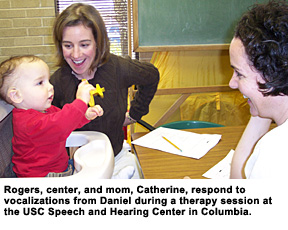


|
|
|
|
|
|
|
|
|
|
|
|
||||||||||||||
|
||||||||||||||
|
|
||||||||||||||
|
||||||||||||||
|
Posted
01/31/2007
By Michelle P. Jordan
Thanks to modern technology, Dr. Cheryl Rogers is able to provide speech and language therapy services right in patients’ homes – without ever leaving her own office. In December, Rogers, a clinical assistant professor, speech-language pathologist and certified auditory-verbal therapist with the University of South Carolina’s Speech and Hearing Center, implemented the center’s first telepractice system in which therapy services are provided in real time online via webcams linking her office with her client’s home. The result is that now, when it is time for her son’s speech and language therapy appointment in Columbia, Catherine O’Grady of Fort Mill, doesn’t have far to go. She simply picks up her 9-month-old, Daniel, and strolls a few feet into the family’s computer room, where Rogers is waiting online to guide O’Grady and her son through an hour-long therapy session. “It’s amazing that (the telepractice) is working like it is,” said O’Grady, whose son has a severe hearing impairment and wears hearing aids. Daniel has been receiving weekly auditory-verbal therapy – a specialized therapy for children with hearing loss, and which promotes listening and spoken language – from Rogers since he was seven weeks old. The center’s new program couldn’t have come at a better time for this busy mother of three young sons. In addition to Daniel, O’Grady and her husband, Kurt Merkle, also are the parents of Steffen, 5, and Lewis, 3.
With the commute, traffic, and side trips to drop off and pick up the older children at school and a babysitter, 90-minute appointments evolved into six-hour-long events for O’Grady. Factor in the cost of gas and childcare, and the costs were beginning to wear, as well. With only a $40 investment in a webcam for their home computer and a high-speed internet connection, O’Grady and Daniel now make the commute to Columbia only every two weeks, with therapy being provided in the alternating weeks via telepractice. Besides the convenience, O’Grady feels the practice has only enhanced Daniel’s progress in therapy. “It keeps me refocused and teaches me what to do (to encourage Daniel’s speech and language) during all the other times when we’re not in therapy,” O’Grady said. “It’s still an aggressive approach to optimize his speech and listening ability.” Training the family is part of the overall auditory-verbal therapy goal, said Rogers of Daniel’s play-based therapy. With the help of telepractice, the family is able to be trained in their home environment, not just in an office setting, making it easier for Daniel’s learning to carry over into other situations. “Parent involvement is crucial because learning doesn’t just happen in the one hour we’re together,” Rogers said. “(Telepractice) gives the parents the opportunity to really take the reins while you talk them through the process, using their own toys.”
For those who have limited access to treatment, though, this program can be invaluable as “extensive travel often results in client fatigue and distraction, reducing the patient’s or families’ desire for, or benefit from, services,” said Danielle Varnedoe, director of the center that provides hands-on experience for speech-language pathology students in Communication Sciences and Disorders, a department of the Arnold School of Public Health. If the increasing number of journal articles is any indication, this burgeoning field of telehealth is set to take off, with many diverse applications. Research has shown telepractice is effective in treating a wide range of communication disorders. “Research in the area of telehealth practices with individuals with communication disorders is encouraging,” Varnedoe said. “A number of treatment outcome studies in the areas of adult neurogenics, dysphagia, and voice disorders found no differences in treatment results or patient satisfaction as compared to ‘face-to-face’ treatment.” Currently, the USC Speech and Hearing Center is implementing this telehealth service on a case-by-case basis based on candidacy criteria, with the goal of making specialized therapy services more accessible to patients who live at a distance from the center, located at 1601 St. Julian Place, Middleburg Office Park.
For more information, contact the USC Speech
and Hearing Center at (803) 777-2614. For more information on children
and hearing loss and auditory-verbal therapy, visit
www.agbell.com. |
| Columbia, SC 29208 • 803-777-7000 • sphweb@gwm.sc.edu | © University of South Carolina Board of Trustees |
 House
calls, which had gone the way of rotary phones and black-and-white TVs,
are making a comeback – but with a very modern twist.
House
calls, which had gone the way of rotary phones and black-and-white TVs,
are making a comeback – but with a very modern twist.  “We really want to do as much (therapy) as
recommended, which means we’re on top of an aggressive therapy
schedule,” O’Grady said. The weekly two-and-a-half-hour commute from
Fort Mill to Columbia and back, though, definitely was getting to be a
drain on the family.
“We really want to do as much (therapy) as
recommended, which means we’re on top of an aggressive therapy
schedule,” O’Grady said. The weekly two-and-a-half-hour commute from
Fort Mill to Columbia and back, though, definitely was getting to be a
drain on the family.  While
telepractice is both beneficial and convenient, O’Grady and Rogers
prefer it not be Daniel’s only means of therapy. In-office appointments
provide the physical contact between a
While
telepractice is both beneficial and convenient, O’Grady and Rogers
prefer it not be Daniel’s only means of therapy. In-office appointments
provide the physical contact between a